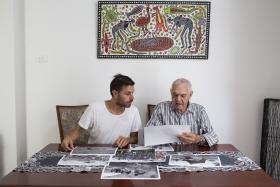Aboriginal identities: Sydney Elders
Learning Intentions
Students are learning to:
- Appreciate the diversity of Aboriginal identities.
- Recognise social and political influences on Aboriginal identities over time.
- Understand how to conduct appropriate community consultation.
Success criteria
Students will be successful when they can:
- Give examples of the diversity of Aboriginal identities.
- Identify social and political influences on Aboriginal identities over time.
- Practice appropriate community consultation protocols.
Student Activities
Learning from Elders
Celebrate the dynamic identities of four Aboriginal Elders from the Sydney Elders exhibition and conduct a case study with Elders from your own community.

Aboriginal Studies Years 7–10 Syllabus (2020)
AST5-1 describes the factors that contribute to an Aboriginal person’s identity
AST5-2 explains ways in which Aboriginal Peoples maintain identity
AST5-3 describes the dynamic nature of Aboriginal cultures
AST5-4 explains adaptations in, and the changing nature of, Aboriginal cultural expression across time and location
AST5-10 identifies and applies appropriate community consultation protocols and ethical research practices to gather, protect and interpret data
Cultural expressions and interpretations
Students:
- explore the diversity of Aboriginal Peoples’ and Torres Strait Islander Peoples’ identities and cultures, and the factors that determine cultural expressions and interpretations in Aboriginal communities, for example:
- geographical location
- histories
- environments
- technologies
- identify similarities and differences in Aboriginal Peoples’ cultural expressions and interpretations
Social factors and experiences
Students:
- identify the social factors and experiences that have affected Aboriginal identities in post-invasion Australian society, for example:
- disconnection of families, including separation of children and the Stolen Generations
- influence of religious groups
- economic factors
- online content, social media and digital communities
Adaptations in cultural expression
Students:
- describe combinations and adaptations of Aboriginal Peoples’ cultural expressions in post-invasion contexts, for example:
- the use of musical instruments in contemporary musical presentations, eg yidaki (didgeridoo, marluk, bamboo), clap sticks, languages
- the use of graphic and visual cultural elements, eg in fashion, décor, graphic design, contemporary arts
- the use of dance and cultural movement, eg dance theatre, sporting contexts
- discuss the validity and significance of adaptations of cultural expression
- explain how adaptations in Aboriginal cultural expressions reflect the dynamic and resilient nature of cultures
Aboriginal Community Identities case study
Students:
- apply ethical research skills, including protocols for consultation, for example:
- free, prior and informed consent
- using Aboriginal-authored or endorsed texts
- sharing research findings
- demonstrate understanding of ethical responsibilities surrounding Indigenous Cultural and Intellectual Property (ICIP), for example:
- permission from appropriate knowledge holders
- acknowledgement, attribution and citation
Students:
- develop knowledge and understanding of similarities and diversity in Aboriginal identities, communities and cultural expression
- develop understanding of the importance of Aboriginal self-determination and autonomy
- develop understanding of Aboriginal Peoples’ ongoing local, regional, national and international roles, and range of relationships with non-Aboriginal peoples
Students:
- develop research and communication skills that use appropriate protocols and ethical practices when working with Aboriginal communities.
Students value and appreciate:
- the diversity of Aboriginal cultures, experiences and perspectives
- the dynamic nature of Aboriginal cultures
- the importance of social justice and equity
- ethical practices.
Cross-curriculum priorities
- Aboriginal and Torres Strait Islander histories and cultures
General capabilities
- Critical and creative thinking
- Intercultural understanding
- Literacy
- Personal and social capability
Background information for teachers and students
Sydney Elders exhibition
In 2018 celebrated Wiradjuri/Kamilaroi artist Jonathan Jones curated an exhibition in the State Library of NSW: Sydney Elders: Continuing Aboriginal Stories. This physical exhibition has now been converted into an online experience on the State Library website.
Following his landmark Kaldor Public Art Project, barrangal dyara (skin and bones), the Sydney Elders project tells the personal story of Aboriginal Sydney through four of its traditional owners – Uncle Dennis Foley, Aunty Esme Timbery, Uncle Charles ‘Chicka’ Madden and Aunty Sandra Lee.
“Each Elder represents different clans that have survived in Sydney,” says Jonathan.
“Together, they tell Sydney’s most important story, its Aboriginal story, and how they have continued the legacy of their ancestors by actively contributing to and creating Sydney.”
Uncle Charles ‘Chicka’ Madden, from Gadigal country, spent most of his life in construction, working on landmark projects, including Qantas House, Gladesville Bridge, Eastern Suburbs railway line and Carriageworks, and today is an active member of the Redfern community and artist.
Aunty Esme Timbery is a celebrated Bidjigal and Dharawal artist and Elder from the Aboriginal mission community of La Perouse. Like her ancestors, she is a renowned shellwork artist whose work has been widely collected.
Uncle Dennis Foley, a Gai‐mariagal man from northern Sydney, worked in education and has published a book on his country, Repossession of Our Spirit: Traditional Owners of Northern Sydney.
Aunty Sandra Lee, a Dharug Elder from Blacktown, is an active member of the Western Sydney Aboriginal community who is constantly pushing for recognition of Dharug people.
Additional resources
Community consultation
Additional information about community consultation can be found in the Board of Studies paper Working with Aboriginal communities: A guide to community consultation and protocols.
Exhibition guide
Read more about Jonathan Jones’ approach to this exhibition in the Exhibition guide.
Gather
Gather connects Aboriginal communities with collection items and stories from the State Library of NSW.
ATSILIRN Protocols
The Aboriginal and Torres Strait Islander Library, Information and Resource Network (ATSILIRN) protocols inform organisations such as the State Library NSW. The full list of protocols are available on the ATSILIRN website.